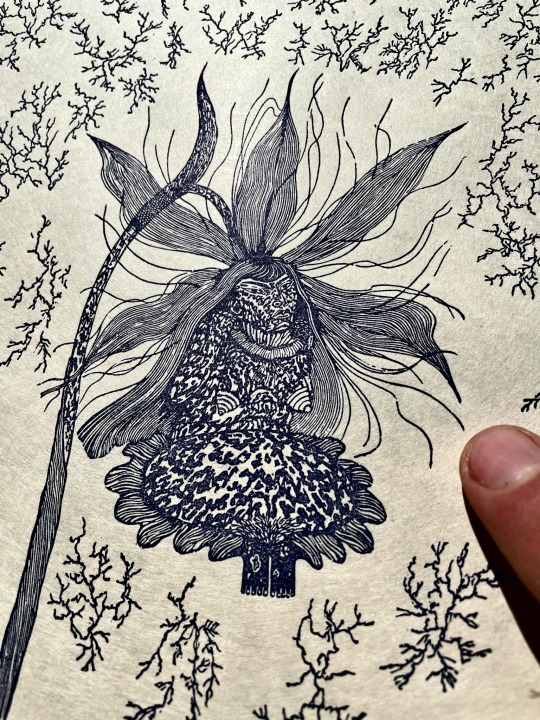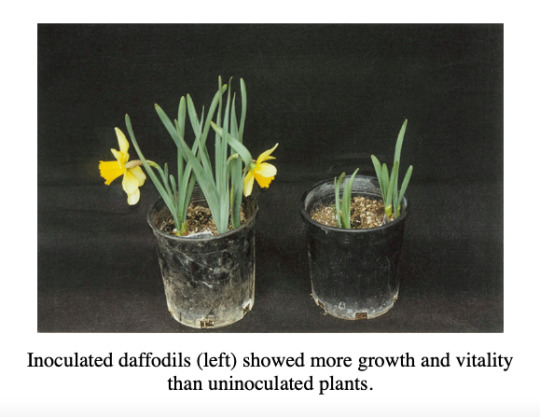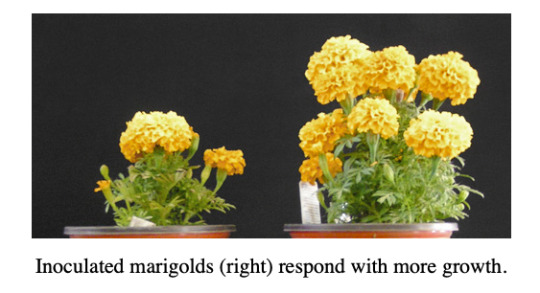#mycorrhizae
Text
The trees don't "help" each other. They don't "decide" to let the fungus in. All they know is that when they call for help, the fungus answers. Without the fungus, they'd be nothing. It's like if a government was part of your body. It's the closest thing they have to a god. Isn't there something horrifying about that, deep down. God exists and you can't escape it. God exists and you can't live without it. God exists and spends every day ensuring that your brother's blood flows through your veins. Deep, deep in your DNA, there is a pact that links you all to the beast underground.
761 notes
·
View notes
Note
Bizarre question for worldbuilding: what kind of fungus would be best at interfacing with electronics? Whether that be actively picking up and transmitting signals or just wiring itself into a keyboard and manipulating it that way; it's a librarian, so I don't have to be picky. I was thinking a cordyceps, but if you have better ideas, I am all (wood) ears!
@specsthespectraldragon Honestly, I think any mycorrhizal fungus would work. The mycorrhizal network of fungal mycelium is already thought to function as a communication network among trees and other plants (though to what degree is debatable.) The signals in a mycorrhizae are chemical rather than electric; there's some evidence for plants sending electrical signals, but I believe that's largely between different parts of one plant rather than among multiple individuals.
Of course, you're working within a fictional setting, so feel free to mess about with this as much as you want. If your world's scientists have discovered that plants evolved ways to extend their electrical signalling capabilities to the mycorrhizae through the fungal mycelium, I think that would be a perfectly reasonable bit of science fiction to toss in there.
Good luck with your project; it sounds like a lot of fun!
#specsthespectraldragon#fungi#mushrooms#mycorrhizae#mycelium#fungus#nature#writing#fiction#worldbuilding
16 notes
·
View notes
Text



Calypso bulbosa. Hand pulled prints
#nature#art#california#mendocino#sonoma#bay area#ink#printmaking#illustration#mokuhanga#linocut#linoleum print#calypso bulbosa#orchids#flowers#mycorrhizae#aestethic
74 notes
·
View notes
Text
So on dendryte's suggestion, I read a paper called "Feed your friends: do plant exudates shape the root microbiome?", and it is awesome and filled with ideas that were new to me, and all in all was very exciting. Like, I didn't even know about/remember border cells, and they apparently do a whole lot! I'm back from work now, so now I'm going to share the Questions I have, and am going to spend the weekend looking for sources on:
1. As crop rotation was developed for a tilled, monoculture system as a way to address the disease issues that pop up in such a system, is crop rotation actually beneficial in a no-till, truly polyculture setting where care is taken to support mycorrhizae?
As we know know that plants alter the population of bacteria in the soil, and that these population compositions differ between plant species, is it possible that there might be some benefits to planting the same crop in the same location if you're not disrupting microbe populations through tilling?
2. Since we know that applications of nitrogen can cause plants to kick out their symbiotic fungal partners, increasing their vulnerability to pathogenic fungi & drought, might it be better to place fertilizer outside of the root zone so as to force the plant to use the mycelium to get at it?
How far can mycorrhizal networks transport mineral nutrients? Are they capable of transporting all the mineral nutrients plants need? In other words, can I make a compost pile in the middle of the garden and be lazy and depend on the fungal network to distribute the goods?
3. How deep can fungal hyphe go? In other words, in areas with shallow wells, and thus fairly shallow water tables, can we encourage mycorrhizae enough to be able to depend on them for irrigation?
4. For folks on city water, does the chlorine effect plants' microbiome both above and below ground?
5. When do plants start producing exudates? If you had soil from around actively growing plants of the same species you're sowing, could the bacteria and fungi play a role in early seedling vigor & health?
6. Has anyone directly compared the micronutrient profiles of the same crop grown in organic but tilled settings against those grown in no-till, mycorrhizae-friendly settings?
7. Since we know that larger molecules, such as sugar, can be transported across fungal networks between different species (Suzanne Simard is where I first food this info) , have we checked for other compounds created by plants? Say, compounds used by plants to protect against insect herbivory?
8. Since we know blueberries use ericoid mycorrhizae rather than endo- or ectomycorrhizae (which are the two types used by most plants), but gaultheria (salal & winter green) use both ericoid & ectomycorrhizae, and alder uses both endo & ectomycorrhizae (and fix nitrogen too!), and clover use endomycorrhizae, might blueberries be more productive if there's a nearby hedge of salal/wintergreen, alder, and clover? Willows and aspens also both use endo & ecto, so they could be included, and the trees could also be coppiced for firewood or basketry supplies.
I'm going to spend some time this weekend reading research papers. If anyone happens to know any that address these (or related questions), please send them my way!
85 notes
·
View notes
Text
Mycorrhizae — The Great Filtration (Big Bovine Industrial Wastes)

youtube
Given its associations with fungi, Mycorrhizae might seem like a name better suited to a death metal band, and the damper and danker, the better. But Travis Minnick’s Mycorrhizae is a black metal project, and when you listen to The Great Filtration, the moniker begins to make some sense. The speed with which fungal lifeforms grow, the flying clouds of tiny spores, the rhizomic proliferation of underground shoots and channels — all that stuff gets registered in Mycorrhizae’s rapidly whirring, buzzing, sinuous sound. It’s simultaneously raw and unexpectedly canorous, rich and fetid and weirdly brittle. Like the taste of a dried candy cap mushroom, Mycorrhizae’s music is layered and complex.
The more complicated question is how seriously we’re supposed to take this stuff. The video Minnick has created for “Strength in Space” is appealingly bananas, and tonally inscrutable. Two dudes in camo and Ghillie suits, one of them snow white, run through dense forest and lovingly shred on their guitars. Are they collecting some shrooms? Stocking up for the apocalypse? Just generally taking the piss? This reviewer sort of loves the way the video plays it straight and, through its sheer, unblinking enthusiasm, seems to undercut its own gravid weightiness.
The music has the same force. It moves at an unflagging top gear, full of riffage and wide-eyed ideas; but it all flies by so quickly that it can be hard to track, and by the sixth song on The Great Filtration (a terrific tune called “Unwielding”), it’s a bit exhausting. That may be part of the band’s symbolic gambit. The deep microbial, organic processes of mycorrhizae are also relentless, remarkable for their energies, essential to life even as their fungoid nature signals dark, cold, underground properties that make us think of death. In that way, Mycorrhizae captures some of the most provoking ambiguities of black metal: it wants to be subterranean, shadowy and dead, but its very essentials render the music vigorous, and very much alive.
Jonathan Shaw
#Mycorrhizae#the great filtration#big bovine industrial wastes#jonathan shaw#albumreview#dusted magazine#black metal
2 notes
·
View notes
Text
not my meme, meme created by nemophilist_tendencies on instagram but look at this. look at this

#i didnt like fungi at first but now theyre growing on me#actuallyautistic#blue squawks#fungi#mycorrhizae
20 notes
·
View notes
Text
Arbuscular mycorrhizal fungi develop, outside the root of their host, a highly branched system (mycelium) of hyphae (fine filamentous structures 2 to 10 μm in diameter) that explores the soil (Figure 5.12).

"Plant Physiology and Development" int'l 6e - Taiz, L., Zeiger, E., Møller, I.M., Murphy, A.
#book quote#plant physiology and development#nonfiction#textbook#arbuscular fungi#mycorrhizae#mycorrhizal network#fungus#symbiotic relationship#mycelium#soil science#plant growth#roots#glomus mosseae#cherry plum#prunus cerasifera
7 notes
·
View notes
Text
Honestly I’ve never played The Last Of Us but if there were a zombie apocalypse… fungi being the culprit for high jacking our bodies seems to me, the most accurate and possible cause of transference and infection - considering our entire world would not be able to function without fungi (ie: mycorrhizal networks)
#the last of us#TLOU#the last of us hbo#the last of us spoilers#fungi#fungai#fungus#mycorrhizal fungi#mycorrhizal network#mycorrhizae#aesthetic#keep it green#ovrgrwn
13 notes
·
View notes
Text
I'm really excited about this garden, because while I grew up on a small organic farm, I've learned a lot in the years since I left home. A lot about mycorrhizae, soil bacteria, interplanting, insectary plants, and passive water catchment techniques, and I'm really excited to try them on a bigger scale than my back yard.
So let's look at a few of the design guidelines I have for this place.
1. Use practices that encourage mycorrhizae & other soil microbiota. In practice, this means we will not dig in the soil if at all possible, we will keep the soil covered with mulches (including living mulches), and we will keep healthy roots in the soil year round (either by having a living mulch or biennial & perennial crops). We will also not be using concentrated forms of fertilizer, such as inorganic, bone meal, guano, etc, as these have been shown to disrupt the relationship between plants & mycorrhizae.
2. With few exceptions, crops will be inter-planted, usually with plants that have been shown to reduce damage to crops, improve the health of the crops, fix nitrogen, or support native insect species.
3. There will be a lot of insectary plants, and large areas for native plants to grow. We will encourage species that support native pollenators & birds, discourage invasive species, and work to make sure our garden benefits the surrounding ecosystem. We will not be using pesticides, herbicides, or inorganic fertilizers.
4. We will be using passive rainwater catchment practices to retain as much soil moisture as possible and reduce irrigation as much as possible. This will look like the use of mulches, incorporating as much organic matter as possible, and possibly the construction of swales.
If you want some resources on these matters, here's a reading list, ranging from memoirs with good info to books with many case studies
The One-Straw Revolution: An Introduction to Natural Farming, by Masanobu Fukuoka
The Ruth Stout No Work Garden Book, by, you guessed it, Ruth Stout
The Complete Guide to Restoring Your Soil, by Dale Strickler
Finding the Mother Tree, by Suzanne Simard
Mycelium Running, Paul Stamets
#gardening#organic gardening#permaculture#save the bees#sustainable gardening#mycorrhizae#no till#no dig#tiny farm
14 notes
·
View notes
Text
Goes without saying that I'm hopelessly dependent on the blue spaghetti


0 notes
Text
I'm really excited about this garden, because while I grew up on a small organic farm, I've learned a lot in the years since I left home. A lot about mycorrhizae, soil bacteria, interplanting, insectary plants, and passive water catchment techniques, and I'm really excited to try them on a bigger scale than my back yard.
So let's look at a few of the design guidelines I have for this place.
1. Use practices that encourage mycorrhizae & other soil microbiota. In practice, this means we will not dig in the soil if at all possible, we will keep the soil covered with mulches (including living mulches), and we will keep healthy roots in the soil year round (either by having a living mulch or biennial & perennial crops). We will also not be using concentrated forms of fertilizer, such as inorganic, bone meal, guano, etc, as these have been shown to disrupt the relationship between plants & mycorrhizae.
2. With few exceptions, crops will be inter-planted, usually with plants that have been shown to reduce damage to crops, improve the health of the crops, fix nitrogen, or support native insect species.
3. There will be a lot of insectary plants, and large areas for native plants to grow. We will encourage species that support native pollenators & birds, discourage invasive species, and work to make sure our garden benefits the surrounding ecosystem. We will not be using pesticides, herbicides, or inorganic fertilizers.
4. We will be using passive rainwater catchment practices to retain as much soil moisture as possible and reduce irrigation as much as possible. This will look like the use of mulches, incorporating as much organic matter as possible, and possibly the construction of swales.
If you want some resources on these matters, here's a reading list, ranging from memoirs with good info to books with many case studies
The One-Straw Revolution: An Introduction to Natural Farming, by Masanobu Fukuoka
The Ruth Stout No Work Garden Book, by, you guessed it, Ruth Stout
The Complete Guide to Restoring Your Soil, by Dale Strickler
Finding the Mother Tree, by Suzanne Simard
Mycelium Running, Paul Stamets
1 note
·
View note
Note
Hello! I see you use the word "mycorrhizal" often, what does it mean?
a "mycorrhiza" refers to a symbiotic relationship between fungi & green plants. a mycorrhizal association will occur when a fungus plays a role in a plant's root system.
"in a mycorrhizal association, the fungus colonizes the host plant's root tissues, either intracellularly as in arbuscular mycorrhizal fungi, or extracellularly as in ectomycorrhizal fungi. the association is normally mutualistic. in particular species, or in particular circumstances, mycorrhizae may have a parasitic association with host plants."
you can read more about it here (link) !! <3
21 notes
·
View notes
Note
Can I use mycorrhizal fungi in potted plants?
Sorry I missed this until just now, but the answer is yes, assuming the plant species are compatible. A lot of research on mycorrhizae is done in pots:



You'll want to verify the plant's mycorrhizal status, which is relatively easy to do with this list: https://mycorrhizae.com/mycorrhizal-status-of-plant-families-and-genera/
55 notes
·
View notes
Text
i wanna make another nnk meta post but like i've already DONE the politics one what the fuck do i do now
#rambles#DO YOU GUYS REMEMBER THAT ONE PERSON WHO MADE POSTS ON HOW TO CARE FOR FAMILIARS IN CHARACTER#i miss them.#i think i said a long time ago i wanted to make posts like that. but i ended up not going into animal care like i thought i was gonna#maybe i should. idk. post about autumnia and climate change or something.#or the mycorrhizae theory of magic. that's a fun one#that's not enough to make a whole big post on though.#i do have thoughts on where magic comes from. and why cross worlds is wrong in some places but right in others#but. idk. they're all kinda unorganised.#these tags could've been in the post. whatever. they're here now
14 notes
·
View notes
Text
Me: *increasingly obsessed with Ben Wheatley psychedelic horror films*
My friends who genuinely couldn’t care less:

#a field in england#in the earth#ben wheatley#reece shearsmith#they’re great friends but they are honestly so confused#fell down a research rabbit hole about mycorrhiza#AFIE#my sad mushroom boys#in the earth 2021
53 notes
·
View notes
